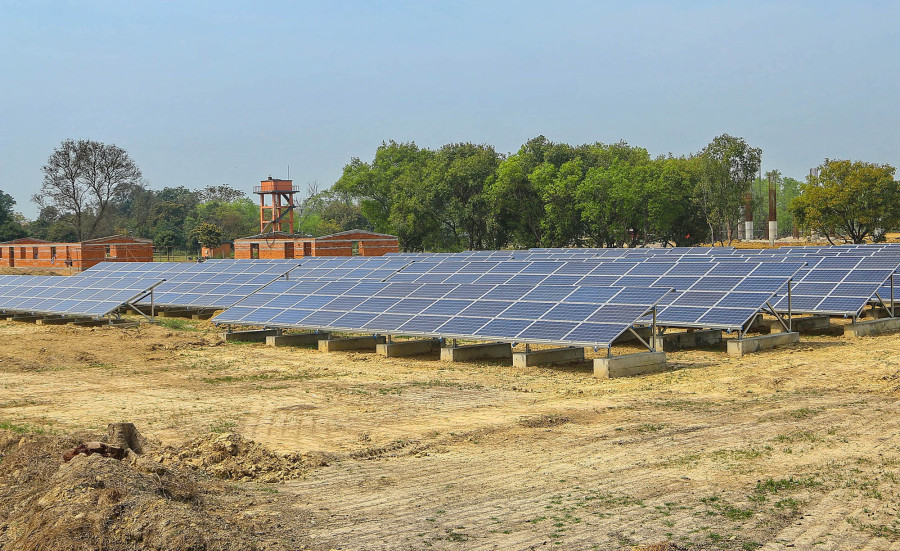Money
Team leaves for Malaysia to study solar technologies at Bhairahawa airport
The Gautam Buddha International Airport, which is due to be completed by early next year, plans to go fully solar.
Prahlad Rijal
A team comprising energy and aviation officials left for Malaysia on Monday to study ways to transform huge tracts of land at Gautam Buddha International Airport into a 10-megawatt solar farm without affecting flight safety.
There are concerns that potential glare hazards from the solar panels set up on the airport’s grounds could pose a safety risk for aircraft pilots.
The airport is poised to become entirely reliant on the sun to meet its energy requirements, the second airport in the world after India’s Cochin International Airport.
“The officials will study the technical and financial aspects of the solar power project implemented at Kuala Lumpur International Airport and prepare a report suggesting the proper technology and methodologies to execute the project in Nepal,” said Manoj Silwal, chief of Project Management Directorate of Nepal Electricity Authority.
The airport in the Malaysian capital is powered by a 19 megawatt direct current solar system installed in 2014. Solar panels with anti-glare features have been mounted on the roof and on the ground at the facility.
According to Silwal, it will require 2-2.5 bighas of land to install 1 megawatt solar panels, and officials have planned to generate around 10 megawatts of power as the airport has ample space available for the purpose.
To put the abundant vacant space at the under-construction international airport to use, the Asian Development Bank has agreed in principle to fund what has been called the green airport project.
The airport, located in south central Nepal, and the gateway to the international pilgrimage destination of Lumbini, is spread over 787 bighas.
Also, the officials will study the proper technology which will be required to make the airport power neutral, ensuring that the infrastructure consumes as much power as it produces.
Once fully solar powered, the entire airport operation—from air traffic control, baggage claim and runway lights to ground control rooms and passenger terminals—will run on solar energy.
Utilising airport space to install solar panels will allow electricity to be generated at the point of consumption, eliminating energy bills and the need for expensive transmission lines and supporting infrastructure.
Apart from studying the technical aspects of the solar powered airport in Malaysia, the team will also study ways to make landings and takeoffs safer, as the harsh glare of the solar panels can distract pilots, putting lives at risk.
“The team will study anti-glare technology used by the airport in Malaysia as safety is of high concern when it comes to operating solar panels at airports,” said Prabesh Adhikari, chief of the Gautam Buddha International Airport project.
Anti-glare technology is used to prevent light pollution at airports, military facilities and ground mounted solar plants adjacent to high rises. This is done by coating an anti-reflective film on the glass of photovoltaic solar panels.
According to Adhikari, after the technical study concludes, talks will advance whether to fund the project with loans or grants from the multilateral lending agency which is also funding the construction of the airport.
The solar plant is estimated to cost nearly $10 million, or $1 million per megawatt, and take around six months to complete.
Initially, the airport was slated to be operational by December 2017. However, fuel and building material shortages due to the months-long Tarai banda in 2015 delayed the upgradation work by six months, and its operation deadline was revised to June 2018.
Subsequently, a dispute over payment between the Chinese contractor and the Nepali subcontractor, Northwest Infra Nepal, stalled work at the construction site for more than six months. As a result, the project deadline was extended many times after the initial extension. The airport is now expected to come into operation by early 2020.
In June, the cabinet also gave an in-principle approval to the Tourism Ministry to appoint international firms for the operational readiness and airport transfer (ORAT) operation of the airport in Bhairahawa through a government to government deal.
ORAT is the best way to ensure that every aspect of a new facility functions flawlessly right from day one. ORAT consultants work with airport stakeholders to formulate new processes, train staff, and test every single new system and procedure from passenger and baggage handling to airside operations.
***
What do you think?
Dear reader, we’d like to hear from you. We regularly publish letters to the editor on contemporary issues or direct responses to something the Post has recently published. Please send your letters to [email protected] with "Letter to the Editor" in the subject line. Please include your name, location, and a contact address so one of our editors can reach out to you.




 9.12°C Kathmandu
9.12°C Kathmandu













%20(1).jpg&w=300&height=200)
